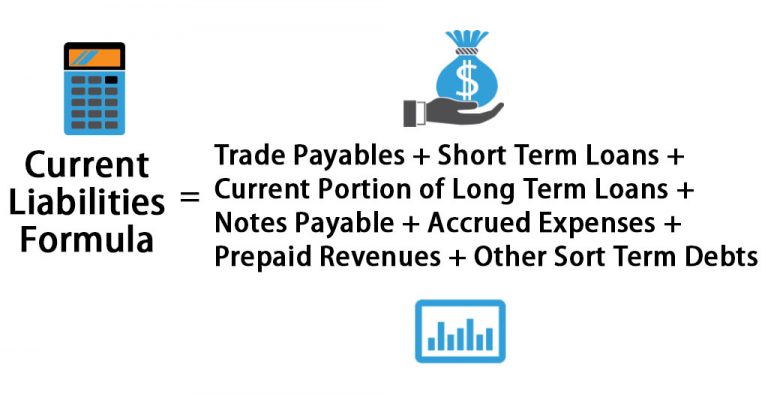current liabilities definition and meaning

Accounts payable are the opposite of accounts receivable, which is the money owed to a company. This increases when a company receives a product or service before it pays for it. However, if one company’s debt is mostly short-term debt, it might run into cash flow issues if not enough revenue is generated to meet its obligations. A note payable is a debt to a lender withspecific repayment terms, which can include principal and interest.A note payable has written contractual terms that make it availableto sell to another party. The principal on a noterefers to the initial borrowed amount, not including interest. Inaddition to repayment of principal, interest may accrue.Interest is a monetary incentive to the lender,which justifies loan risk.
Thinking about Unearned Revenue
- The adjusting journal entry will make a debit to the related expense account and a credit to the accrued expense account.
- If a company has too much-working capital, some assets are unnecessarily being kept as working capital and are not being invested well to grow the company long-term.
- Until the customer is provided an obligated product or service, a liability exists, and the amount paid in advance is recognized in the Unearned Revenue account.
Accounts payable accounts for financial obligations owed to suppliers after purchasing products or services on credit. This account may be an open credit line between the supplier and the company. An open credit line is a borrowing agreement for an amount of money, supplies, or inventory. The option to borrow from the lender can be exercised at any time within the agreed time period.
Current Liabilities on the Balance Sheet FAQs
As a result, credit terms and loan facilities offered by suppliers and lenders are often the solution to this shortfall. Current liabilities are used to calculate financial ratios which analyze a company’s ability to meet its short-term financial obligations. Current liabilities are listed on a company’s balance sheet below its current assets and are calculated as a sum of different accounting heads. Current liabilities are generally a result of operating expenses rather than longer-term investments and are typically paid for by a company’s current assets. High levels of current liabilities can negatively impact a company’s profitability due to high-interest payments on debts or other obligations. Companies should strive to keep their total amount of current liabilities as low as possible in order to remain profitable.
Short-Term and Current Long-Term Debt

These invoices are recorded in accounts payable and act as a short-term loan from a vendor. By allowing a company time to pay off an invoice, the company can generate revenue from the sale of the supplies and manage its cash needs more effectively. Car loans, mortgages, and education loans have an amortizationprocess to pay down debt.
The value of the short-term debt account is very important when determining a company’s performance. Simply put, the higher the debt to equity ratio, the greater the concern about company liquidity. If the account is larger than the company’s cash and cash equivalents, this suggests that the company may be in poor financial health and does not have enough cash to pay off its impending obligations. A company incurs expenses for running its business operations, and sometimes the cash available and operational resources to pay the bills are not enough to cover them.
What Is Short-Term Debt?
That is to say, notes and loans are usually listed first, then accounts payable, and finally accrued liabilities and taxes. Another way to think about burn rate is as the amount of cash a company uses that exceeds the amount of cash created by the company’s business operations. Many start-ups have a high cash burn rate due to spending to start the business, resulting in low cash flow. At first, start-ups typically do not create enough cash flow to sustain operations. Being part of the working capital is also significant for calculating free cash flow of a firm. Short-term debt includes short-term bank loans, lines of credit, and short-term leases.
It is used to help calculate how long the company can maintain operations before becoming insolvent. The proper classification of liabilities as current assists decision-makers in determining the short-term and long-term cash needs of a company. Current liabilities on the balance sheet impose restrictions on the cash flow of a company and have to be managed prudently to ensure that the company has enough current assets a current liability is defined as: to maintain short-term liquidity. In most cases, companies are required to maintain liabilities for recording payments which are not yet due. Again, companies may want to have liabilities because it lowers their long-term interest obligation. At month or year end, a company will account for the current portion of long-term debt by separating out the upcoming 12 months of principal due on the long-term debt.
Next month, interest expense is computed using the new principal balance outstanding of $9,625. This means $24.06 of the $400 payment applies to interest, and the remaining $375.94 ($400 – $24.06) is applied to the outstanding principal balance to get a new balance of $9,249.06 ($9,625 – $375.94). The annual interest rate is 3%, and you are required tomake scheduled payments each month in the amount of $400. You firstneed to determine the monthly interest rate by dividing 3% bytwelve months (3%/12), which is 0.25%.
For example, the 12 upcoming monthly principal payments on a mortgage or car loan are considered to be the current portion of long-term debt. The treatment of current liabilities for each company can vary based on the sector or industry. Current liabilities are used by analysts, accountants, and investors to gauge how well a company can meet its short-term financial obligations. A percentage of the sale is charged to the customer tocover the tax obligation (see Figure 12.5).